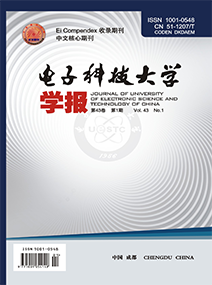-
分岔作为非线性系统的一种常见现象,近年来相关研究大量涌现[1-3]。分岔控制的目的是为了改变系统动态性能以获得期望的系统特性,其主要目标包括:延迟系统分岔的发生、镇定不稳定的分岔、改变已有分岔点的参数值、修正分岔的形状和类型、改善分岔点附近的系统特性,或者这些目标的某些组合[4]。Hopf分岔是分岔中的一种重要类型,其实际意义在于Hopf分岔是系统状态处于稳定和不稳定之间的一种临界状态,所以对其研究非常重要,相关研究成果也很多[5-7]。
在实际的工程系统中,Hopf分岔系统也广泛存在,涵盖了很多的领域,包括:电力系统[8]、电子技术[9]、网络技术[10]、新能源[11]、光学技术[12]等,而很多工程中的问题在实际分析和计算时都会涉及到Hopf分岔的控制问题。Hopf分岔的控制是控制工程和电子技术等领域的重点研究方向之一,有大量的研究成果,包括实际工程应用[13]和理论研究[14]。
随着研究的深入,参数化控制器逐步应用在了Hopf分岔系统的控制中[15-16]。文献[15]在这方面做出了重要的工作,其根据状态反馈理论,给出了一种相对通用的Hopf分岔控制形式,并通过实例对控制器的参数进行了求解和仿真。文献[16]对文献[15]的部分工作进行了进一步的深入,对控制器进行了简化,在控制参数平面上绘制了约束条件曲线,并以此对系统的分岔情况进行了分析。
尽管在Hopf分岔控制器设计方面已经存在大量的研究,但是目前的研究文献中依然存在一定的局限性,如控制器形式复杂不够通用、控制阶次较高、约束条件求解繁琐、参数求解不充分。在现有的研究中,文献[15]使用参数化控制的方法在Hopf分岔控制方面进行了很好的应用,用不等式的方式对求出的控制器参数范围进行了描述,分岔控制效果明显。但是,该文献设计的控制器中含有系统全部的平衡点,表达式结构非常复杂,阶次很高,控制器的阶次是原系统平衡点的整数倍。文献[16]对这种参数化的控制器进行了明显的简化,去掉了原控制器中大部分的高次项,使得控制器的阶次降低,使用柱形代数剖分方法将控制器的约束条件绘制在了二维空间中,并对各个子空间的分岔情况进行了分析。但是该文献中设计的控制器阶次依然较高,且控制器中含有原系统平衡点的值。文献[17]对文献[16]中的参数化方法做了进一步的应用,但是没有对控制器形式进行改进。
因此本文提出了一个简单通用的参数化控制器设计方法,使用该方法设计的控制器阶次更低,控制器中不含有系统平衡点的值,并且不会改变原系统平衡点的位置。
HTML
-
考虑如下具有Hopf分岔的非线性系统:
式中,表示X针对时间t的导数;X ∈ Rn表示X是实数域n维的状态向量;μ ∈ R是一个标量参数,称为分岔参数。注意:通常μ可以考虑成m维的向量,1≤m≤n。F(X, μ)是一个具有Hopf分岔的非线性多项式系统矩阵,并且满足如下的条件:
1)令X*为系统的平衡点,使得针对任何μ都存在;
2)当μ变化使得μ=μ*时,系统在平衡点X*附近将产生一簇极限环。
-
针对系统式(1)设计一个通用的非线性状态反馈控制形式:
增加控制器后,为了不改变原系统的平衡点值,控制器u需要满足如下的条件,即:
针对系统式(1),考虑通用性,令:
式中,。设:
式中,
$\{ {c_{0i}},{c_1},{c_{k + 1}},{c_{n + k + 1}} \in R\} $是控制器的参数。这样控制器u(X, μ)能够镇定系统式(1)并且稳定系统的分岔[6]。
注1:该控制器中g(X, μ)形式简单,是由系统状态变量组成的多项式,且其中不包含系统的平衡点,而且通常情况下2次项是不需要的。相较于文献[15-16],设计的控制器更简单、适用,控制器中不含有系统的平衡点。
注2:u(X, μ)中可以有多个分量,但是通常一个分量就能满足控制系统的要求。
注3:控制器式(3)是由原系统状态方程的矢量组合构成,控制器本身不含有系统平衡点的值,且增加控制器后不会改变原系统平衡点的位置。
注4:式(3)所描述的控制器适用于大多数的系统,但是给出严格的数学证明比较困难。接下来的讨论中将通过一个三维系统的控制器设计来展开说明设计过程。
-
定理1对于k阶实多项式B(X)和m阶实多项式A(X),X ∈ Rn,k≥1,m≥1,如果在X=X0处存在B(X0)=0,则必然存在p阶实多项式L(X),0≤p < k,使得L(X0)=A(X0)。
证明:
根据多项式除法,A(X)可以写为:
式中,A(X)是B(X)除A(X)的整式部分;LA/B(X)为B(X)除A(X)的余式部分。令L(X)=LA/B(X),则在根X0处必然存在L(X0)=A(X0)。
定理2一个具有Hopf分岔的3阶非线性系统可以描述为以下的形式:
式中,μ是分岔参数;。系统式(4)的Jacobi矩阵满秩。考虑式(3)并适当简化,可以得到如下的参数化控制器:
式中,${u_j}(\mathit{\boldsymbol{X}},\mu ) \ne 0$;;$j = 1,\;2,\;3$;;$\{ {c_{0k}},\;{c_i} \in R,\;i = 1,2,3,4\} $; c0k、ci是控制器参数。则在Hurwitz判据确定的约束条件内,通过选择控制器参数c0k、ci,系统式(4)能够实现在平衡点附近的控制。
证明:
不失一般性,通常控制器式(6)可以写成如下的简化表达形式:
在系统式(4)上增加控制器式(7)后则闭环表达式可以写为:
这样闭环系统的Jacobi矩阵描述为:
式中,
设系统的一个平衡点,则根据Jacobi矩阵,系统在平衡点处的特征方程描述为:
式中,
通过特征方程系数可以看出,当X=X0,$\frac{{\partial {f_n}}}{{\partial {x_j}}}$和fn的值是确定的,。且由于原系统Jacobi矩阵满秩,则在特征方程系数a1、a2、a3的表达式中与控制器参数相关的多项式不可能同时为零,因此a1、a2、a3的数值和符号可以通过c01、ci进行改变。又因为a0>0,根据Hurwitz判据并考虑到定理1,设系统式(4)的平衡点方程为G(X0)=0,则对于控制器参数可以得到如下的约束条件:
式中,a4=a1a2-a0a3。因此,在Hurwitz判据确定的约束条件内,通过选择适当的控制器参数c0k和ci,能够在平衡点附近实现对系统式(4)的稳定控制。
注5:约束条件l4中,如果出现l4=0则说明系统处于临界稳定状态,即Hopf分岔,其状态特性表现为等幅震荡;如果l4>0,则系统状态收敛,即稳定,接下来的分析设计中将只考虑稳定时的情况。
1.1. Hopf分岔系统描述
1.2. 参数化控制器设计
1.3. 主要定理
-
人们已经在量子物理、电子电路、磁物理、通讯技术、无线探测等众多领域中对Lorenz系统进行了大量的研究工作。接下来将使用Lorenz系统对控制器设计过程进行说明和验证。
-
Lorenz系统可以描述为:
式中,a、b、c是可变参数,这些参数对系统特性有着直接影响,细微的参数变化都有可能导致系统轨迹由稳定转变为分岔,甚至是混沌[15]。根据式(10),求出系统的平衡点方程为:
-
根据式(7),控制器可以设计为:
式中,${c_0} \in R$,${c_1} \in R$,${c_2} \in R$,${c_3} \in R$,${c_4} \in R$是控制器参数。根据式(10),控制器变为:
Lorenz系统的状态特性直接受到系统参数的影响,随着系统参数的变化,系统状态轨迹会从稳定转变为分岔甚至混沌。为了验证控制器的性能,本文选择系统参数$a = 4,b = 16,c = 1$,根据文献[15],没有控制器时系统的状态特性是混沌的。将系统参数带入Lorenz系统式(4),可以得到新的系统为:
根据式(13),系统在平衡点处的方程为:
为了简化计算过程,令${c_0} = 0,{c_3} = 0$,控制器可以简写为:
将式(15)带入,计算和整理后的系统约束条件为:
充分求解约束条件式(16)~式(19)组成的不等式组非常困难。式(16)~式(19)平衡点处的方程式(14)构成了一个半代数集,使用柱形代数剖分方法可以对这个半代数集进行充分求解,从而将不等式组的求解问题转换成控制器参数空间的区域划分问题。
2.1. Lorenz系统描述
2.2. 控制器设计及约束条件计算
-
下面将进行数值化仿真。由于控制器式(15)中含有c1、c2、c4共3个参数,直接用柱形代数剖分方法对控制器的半代数集求解后得到的参数区间将由多个不等式组描述,不够直观。为了进一步简化约束条件,在系统的3个平衡点,,处对约束条件进行计算和分析。
在平衡点E0处:
在平衡点E-处:
在平衡点E+处:
由于系统稳定,分析式(20)~式(22)可得:
而根据式(23),有:
从而可以得到${c_1} \in [ - 5, - 1)$,当${c_1} = - 5$时,${l_{40}} = 0$。本文只考虑稳定的情况,则${c_1} \in ( - 5, - 1)$。接下来将使用柱形代数剖分计算系统的控制器参数。
为了简化计算过程,选择${c_1} = - 3$,此时系统在平衡点E0处的状态是稳定的。${c_1} = - 3$带入约束条件式(24)~式(31),这样使用柱形代数剖分方法可以得到控制器的参数区间。新的约束条件为:
此时控制器还有c2和c4两个参数需要确定,根据系统在平衡点E-和E+处的情况使用柱形代数剖分计算可以得出c2和c4的参数范围。
由约束条件式(33)~式(40)组成的方程组的隐函数曲线被绘制在二维空间上,如图 1所示。按照柱形代数剖分理论,对这些函数曲线划分的区域进行搜索,最终得到区域Qs,在该区域内,选择参数c2和c4能够实现系统的镇定。区域Qs的边界是L1和L2,其中L1是式(40)的方程l4+=0的一部分,L2是式(36)的方程l4-=0的一部分,其函数方程分别为:
为了证明控制器的有效性,对系统进行了数值化仿真,仿真结果如图 2~图 4所示。在这种情况下,控制器参数${c_0} = 0,{c_1} = - 3,{c_2} = 1,{c_4} = 1$。
图 2是系统在E0处的轨迹,轨迹是收敛的。图 3是在E-处的轨迹,图 4是在E+处的轨迹,这两个轨迹都是收敛的。
具有多个平衡点的非线性系统控制时,通常只能保证系统状态在平衡点附近的局部稳定性,即在平衡点附近的一个邻域内能够使系统轨迹收敛到该平衡点。本文仿真时系统在平衡点E0、E-、E+处的初始值分别为:(0, 1, -1),(-4, -4, 16),(4, 4, 16)。
-
本文针对一类具有Hopf分岔的非线性系统提出了一种参数化镇定方法,并对三维时情况进行了证明。使用该方法,设计的控制器结构简单,控制器参数求解充分,不会改变原系统平衡点的位置,能够实现系统的稳定控制。以Lorenz系统作为实例,说明了参数化控制器的设计过程。最后通过数值化仿真证明了本文提出方法的有效性。

 ISSN
ISSN 












 DownLoad:
DownLoad:


